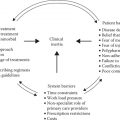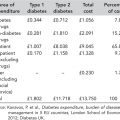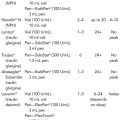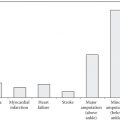Advantages and disadvantages of new therapies
Efficacy based on haemoglobin A1c (HbA1c) lowering and tolerability are no longer the only criteria for the success of a new drug for type 2 diabetes; ease of administration, convenient dosing, weight reductions or weight neutrality, a low hypoglycaemic risk and beneficial effects on cardiovascular outcomes are all important factors.
Type 2 diabetes is associated with a number of pathophysiological abnormalities, including peripheral insulin resistance, impaired regulation of hepatic glucose production and declining β-cell function. No single anti-diabetes agent can correct all the abnormalities. In addition, the decrease in HbA1c that can be achieved with a single agent is, at most, 1.0%–1.5% (11–16 mmol/mol) depending upon the starting level. In people with newly diagnosed type 2 diabetes and HbA1c >8.0% (64 mmol/mol), lifestyle changes and a single pharmacotherapeutic agent commonly will not achieve and maintain appropriate blood glucose levels. Options in this case are to prescribe combination therapy immediately or to intensify beyond first-line therapy promptly if glycaemic targets are not rapidly achieved (say within 3 months). The newer agents fulfil a need for treatments with mechanisms of action that can be used in combination, providing additive blood glucose control with a low risk of adverse events, such as hypoglycaemia or weight gain. For these reasons, more modern agents may have important advantages over some of the older therapies (Tahrani et al., 2016).
OLDER THERAPIES
Metformin
Metformin primarily reduces elevated blood glucose by decreasing hepatic glucose production and, to a lesser extent, by decreasing peripheral insulin resistance. It does not stimulate insulin release. There is universal agreement among guidelines for the management of type 2 diabetes for metformin as first-line therapy in those in whom lifestyle interventions are insufficient to control hyperglycaemia. In addition to achieving significant reductions in HbA1c, it does not cause weight gain or hypoglycaemia, improves lipid profiles and may have possible benefits on cardiovascular outcomes. There is also preliminary evidence that it may protect against certain types of cancer. It is one of the least expensive oral anti-diabetes agents.
Metformin is very rarely associated with lactic acidosis, and as its major route of excretion is via the kidneys, it has been contraindicated in people with renal failure. However, since this labelling was established several decades ago, research has shown no increased risk for lactic acidosis in patients with mild to moderately impaired renal function (estimated glomerular filtration rates [eGFRs], 30–60 mL/min per 1.73 m2) (Ekström et al., 2012; Inzucchi et al., 2014). The National Institute for Health and Care Excellence (NICE) suggests that metformin should not be started with an eGFR <45 mL/min (NICE, 2015). However, it advises if a patient is already suitably controlled using metformin, it may be appropriate to continue its use down to an eGFR of 30 mL/min, provided there is frequent monitoring of renal function and appropriate dose adjustment.
The major drawback with conventional metformin therapy is the requirement for multiple daily doses and dose escalation-related gastrointestinal side effects, although these can be reduced by appropriate titration and dosing prior to or with meals.
Modified-release metformin
A modified-release formulation of metformin has been developed, which is administered once daily and is now available generically. The slower absorption with this formulation may improve gastrointestinal tolerability in some patients and allow for more convenient once-daily dosing which can improve adherence. NICE 2015 guidelines suggest that a trial of modified-release metformin can be initiated if a patient experiences gastrointestinal side effects with standard-release metformin (NICE, 2015).
Sulphonylureas
Sulphonylureas increase insulin secretion by binding to specific receptors on the β cells, resulting in closure of potassium ATP channels. This leads to β-cell depolarization, influx of calcium and activation of the secretory machinery that releases insulin. They require some residual β-cell function for their blood glucose-lowering effect. Follow-up of over 17,000 drug-naive people in the Swedish National Diabetes Register has shown that when used as monotherapy, sulphonylureas (and glinides) were associated with a substantially increased risk of switch to a new agent or addition of a second agent compared with metformin indicating reduced glycaemic durability (Ekström et al., 2015).
Until recently, sulphonylureas have been considered the drug of choice for add-on therapy to metformin. They vary considerably in their metabolism and route of elimination, but all are associated with weight gain and with hypoglycaemia as they stimulate insulin secretion virtually independently of plasma glucose levels. The risk is lower with shorter acting agents than those which are either long acting per se or give rise to active metabolites that substantially prolong their pharmacodynamic effects, such as glibenclamide and chlorpropamide. To avoid accumulation and increased risk of hypoglycaemia, long-acting agents should be particularly avoided in the elderly and those with renal impairment. Given the risks of hypoglycaemia with all sulphonylureas, it is the author’s opinion that as far as possible sulphonylureas should be avoided in these types of high-risk patients, particularly because other agents that do not increase hypoglycaemia risk are now available.
Sulphonylureas are also listed as an option for initial therapy in patients in whom metformin is contraindicated or not tolerated and as a dual therapy option with metformin in both the latest NICE and European Association for the Study of Diabetes (EASD)/American Diabetes Association (ADA) guidelines. They can also be particularly useful as first-line agents in patients who are significantly symptomatic at diagnosis as they work rapidly to improve glycaemic control and symptoms. Given their lack of durability and problems of weight gain and hypoglycaemia, if such an approach is used, it is the author’s practice to switch to an alternative agent once management is established and symptoms improved/relieved.
Meglitinides
Meglitinides or glinides have a similar mechanism of action to the sulphonylureas, but differ in their β-cell binding sites, receptor affinity and absorption and elimination rates. This results in differences in potency, rate of onset and duration of action. The glinides are rapid-acting insulin secretagogues that lower post-prandial glucose excursions by targeting early-phase insulin release, but have no impact on fasting glucose. As with the sulphonylureas, glinide-induced insulin stimulation is dependent on functioning pancreatic β cells. Although repaglinide has been approved for almost 20 years, there have been no relevant trials to date of longer duration than 14 months and therefore no long-term outcome data. The multiple dosing requirements of repaglinide (15 min before a meal) have previously inhibited uptake in clinical practice. A meta-analysis has shown that the risk of hypoglycaemia is at least as high as that of sulphonylureas with similar weight gain (Phung et al., 2010). Finally, repaglinide is only authorised for use as monotherapy or in combination with metformin, meaning that if optimal results are not achieved as initial therapy, no licensed options to intensify with another agent are available.
Thiazolidinediones (glitazones)
Pioglitazone does not increase the risk of hypoglycaemia, but is renowned for promoting weight gain. It may still have a therapeutic role in the management of selected patients, but care should be taken, given it is associated with weight gain and oedema and an increased risk of heart failure. Fracture risk also needs to be seriously considered particularly in the elderly and specifically in postmenopausal women. It remains an option for initial therapy in patients in whom metformin is contraindicated or not tolerated and as a dual or triple therapy option with metformin in both the latest NICE and EASD/ADA guidelines.
Alpha-glucosidase inhibitors
Alpha-glucosidase inhibitors (e.g. acarbose) act by inhibiting alpha-glucosidase in the brush border cells that line the small intestine, which cleaves more complex carbohydrates into sugars. The greatest effect of this agent is therefore on post-prandial hyperglycaemia, and HbA1c reductions are in the region of 0.5% (5.5 mmol/mol). Gastrointestinal side effects are extremely common and include abdominal discomfort, bloating, flatulence and diarrhoea. Therapy with acarbose has been linked to elevations in serum transaminase levels, and the use of this agent is contraindicated in patients with liver cirrhosis. Likewise, concentrations have been shown to increase proportionally with the degree of renal dysfunction. Other contraindications include patients with inflammatory bowel disease or a history of bowel obstruction. These agents are rarely used in Europe but more commonly in China, Japan and elsewhere.
NEWER THERAPIES
Incretin-based therapies
These include the dipeptidyl peptidase-4 (DPP-4) inhibitors (gliptins) and glucagon-like peptide 1 receptor agonists (GLP-1 RAs).
Their development was based on the science behind the role of GLP-1 in glucose homeostasis. GLP-1 is a naturally occurring molecule secreted by the gut in response to food. It promotes insulin secretion from the pancreatic β cells and inhibits glucagon secretion from the pancreatic alpha cells, the latter then inhibiting hepatic glucose production. GLP-1 slows stomach emptying, provoking a feeling of ‘fullness’ and reducing post-prandial hyperglycaemia. It also has a central appetite suppressant effect. Importantly, GLP-1 secretion is glucose dependent; that is, it only exerts its effects in response to a meal when glucose levels are rising or high and its effect ‘switches off’ once glucose levels normalise.
In people with type 2 diabetes, continuous intravenous infusion of GLP-1 has a dramatic effect in improving glucose control. It is not a practical option as a therapy, however, as it has a half-life of only 1−2 min. This is because it is very rapidly broken down by the naturally occurring enzyme DPP-4 to inactive products. This has led to the development of two new drug classes: (1) the DPP-4 inhibitors that allow naturally produced GLP-1 to act for longer and (2) GLP-1 RAs that have similar actions to GLP-1 but are not broken down by DPP-4. This prolongs their active life and allows them to be given by subcutaneous injection twice daily, once daily or even once weekly depending on the characteristics of the GLP-1 RA in question.
DPP-4 inhibitors
The DPP-4 inhibitors increase GLP-1 availability by preventing its degradation. As stimulation of the GLP-1 receptor is indirect, increases in endogenous GLP-1 and decreases in glucagon secretion are more modest than with the GLP-1 RAs. DPP-4 inhibitors predominantly affect the post-prandial plasma glucose excursion, but a modest reduction in fasting plasma glucose is also observed. They are approved for treatment of hyperglycaemia as mono-, dual and triple oral therapies as well as in combination with insulin. A large meta-analysis of DPP-4 inhibitor trials reported that compared with placebo, the DPP-4 inhibitors reduced HbA1c by around 0.7% (Monami et al., 2010). The efficacy was similar in monotherapy and in combination with other agents. They are not associated with weight gain and have a very low risk of hypoglycaemia. DPP-4 inhibitors are administered once daily in tablet form (sitagliptin, saxagliptin, alogliptin, linagliptin), except vildagliptin that is given twice daily. All are also available as fixed-dose combinations with metformin, and linagliptin is also available as a fixed-dose combination with the sodium-glucose cotransporter-2 (SGLT-2) inhibitor empagliflozin.
The DPP-4 inhibitors are generally extremely well tolerated, and the most frequent adverse event in clinical trials was nasopharyngitis. Like the GLP-1 RAs, pancreatitis has been reported in post-marketing surveillance for the DPP-4 inhibitors, and their use should be avoided in patients with a history (or at high risk) of the condition. The U.S. Food and Drug Administration (FDA) has also recently added a new warning about the potential risk for severe joint pain to the labels of all products in the DPP-4 inhibitor class.
Most DPP-4 inhibitors (sitagliptin, vildagliptin, saxagliptin, alogliptin) are predominantly cleared by renal excretion, but with differences in active metabolites. As a result, the total exposure to the drug is increased in proportion to the decline of GFR, leading to recommendations for appropriate dose reductions according to the severity of chronic kidney disease (CKD). Sitagliptin is largely excreted unchanged in the urine, but can be used with dose reduction. Vildagliptin is metabolised to inactive metabolites, which are then renally excreted. Usually given at a dose of 50 mg twice daily, this should be halved to 50 mg once daily in patients with moderate or severe renal impairment, and it can be used with caution in those with end-stage renal disease. Saxagliptin is metabolized mainly in the liver to an active metabolite that is renally excreted. The usual dose should be halved in patients with moderate or severe renal impairment. Linagliptin is excreted almost entirely unchanged in bile and not by renal excretion, making it a useful drug for patients with any degree of renal impairment (including dialysis) without dose adjustment.
Three cardiovascular outcome trials with the DPP-4 inhibitors have been completed. In Saxagliptin Assessment of Vascular Outcomes Recorded in Patients with Diabetes Mellitus—Thrombolysis in Myocardial Infarction 53 (SAVOR-TIMI 53) (Scirica et al., 2013) and Examination of Cardiovascular Outcomes with Alogliptin versus Standard of Care (EXAMINE) (White et al., 2013), neither saxagliptin or alogliptin differed from placebo in terms of the composite primary endpoint: cardiovascular death, non-fatal myocardial infarction (MI), and non-fatal stroke. However, in both trials, concerns were raised about heart failure. In SAVOR-TIMI 53, saxagliptin-treated subjects had significantly higher rates of heart failure hospitalisation (but not heart failure-related mortality) compared with placebo: 3.5% (n = 289) vs. 2.8% (n = 228) over 2.1 years of follow-up (hazard ratio [HR] 1.27; 95% confidence interval [CI] 1.07–1.51; p = .007). Post-hoc analyses of the EXAMINE trial showed that, over a relatively short follow-up of 1.5 years, hospitalisation for heart failure occurred in numerically more patients receiving alogliptin than placebo (3.9% [n = 106] vs. 3.3% [n = 89]; HR 1.19; 95% CI 0.90–1.58; p = .22), but this was not significant.
The Trial Evaluating Cardiovascular Outcomes with Sitagliptin (TECOS) randomized 14,671 patients with type 2 diabetes and established cardiovascular disease to add either sitagliptin or placebo to their existing therapy (Green et al., 2015). After a median follow-up of 3.0 years, there was no difference in the primary outcome (cardiovascular death, non-fatal MI, non-fatal stroke or unstable angina) compared with placebo. Importantly, sitagliptin in the TECOS was not associated with any signal for heart failure.
Overall, the TECOS, SAVOR-TIMI 53 and EXAMINE trials have demonstrated the cardiovascular safety of the DDP-4 inhibitors in high-cardiovascular-risk patients with type 2 diabetes. A recent large observational study involving almost 1.5 million people with type 2 diabetes in the United States, Canada and the United Kingdom found that the use of incretin-based therapy was not associated with an excess risk for heart failure-related hospitalisation compared with use of other anti-diabetes drug combinations (Filion et al., 2016). This was the case for both DPP-4 inhibitors and GLP-1 RAs, and for people with and without histories of heart failure. It remains to be seen whether there are any differences between the various agents in terms of associated risk for heart failure.
In the NICE and ADA/EASD 2015 guidelines, DPP-4 inhibitors can be considered for dual therapy with metformin if blood glucose levels are not controlled on metformin monotherapy. They can also be used in combination with pioglitazone or a sulphonylurea if metformin is contraindicated or not tolerated and as a triple oral therapy option with metformin and either pioglitazone or a sulphonylurea. They can also be used as a first-line therapy where metformin is not tolerated or contraindicated.
Stay updated, free articles. Join our Telegram channel

Full access? Get Clinical Tree








